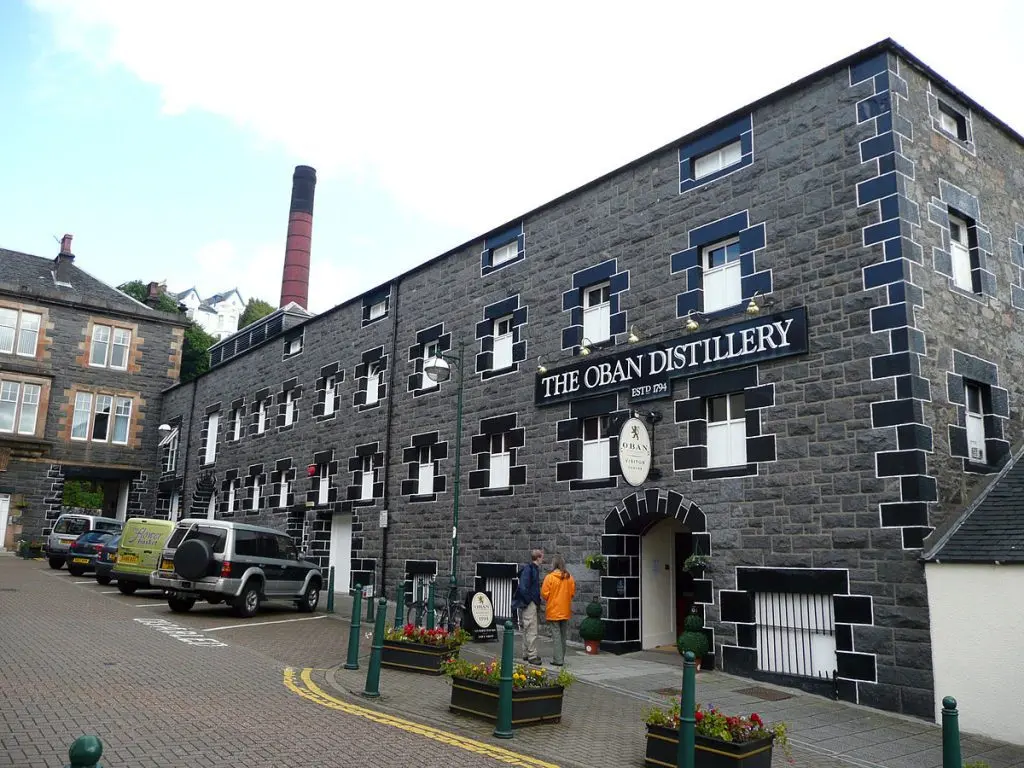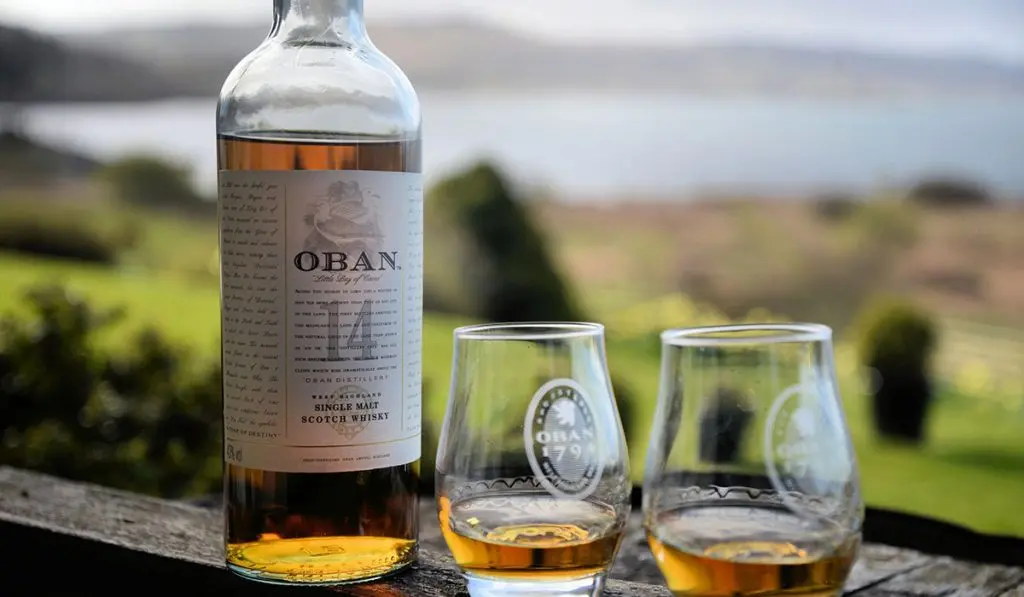The appearance of Oban whiskey in the American television series The Newsroom as the favorite drink of Charlie Skinner, masterfully played by Jeff Daniels, can be seen as a publicity stunt. But the use of the Oban bottle in the third version of the popular Call of Duty video game already seems like a confession. The taste of the favorite drink of Captain John Price, the protagonist of the game, is mild, like most continental scotches, but smoky, like island drinks. Sweetish pear-caramel aroma with subtle notes of citrus eloquently testifies to aging in Montilla Fino sherry casks.
Historical reference. The bustling port city of Oban in the northwest of Scotland has become popular thanks to:
- transport opportunities – ferry connection with the Hebrides (Innse Gall), scattered across the Atlantic;
- Walter Scott, who came here for inspiration in 1814 and left a year later, having written a book about Robert I the Bruce, the great monarch of Scotland – “The Lord of the Isles”;
- the pseudo-Colosseum, built according to the Roman model at the beginning of the last century by the banker and philanthropist John McCaig;
- one of the oldest distilleries in Scotland, located right in the city center.
It cannot be said that the distillery caused the emergence of the city – it was already living its own life, when in 1794 the Stevenson brothers (Hugh, John and James Stevenson) bought the building of an empty hotel in the center and turned it into a small factory. But the fact that the distillery has increased the glory of the city is undeniable. The brothers were engaged in several things at once: they mined and sold slate, equipped ships for those who wanted to walk along the coast to the port of Greenock, and gradually developed family production. In 1866, the Stevenson heirs nevertheless sold the distillery to local merchant Peter Kamsty, considering the business too troublesome and unprofitable.
Just 7 years later, in 1883, the distillery passed into the hands of Walter Higgins, who reconstructed the production, modernized the equipment, increased the area by adding several neighboring buildings. By 1887, the distillery produced about 35 gallons of whiskey (an English gallon is 4,5 liters).
In 1898, Higgins profitably sold the already registered Oban brand and distillery to Aultmore distillery owner Alexander Edwards, the main liquor supplier to Pattison Ltd. The Pattinson brothers were scammers – counterfeit drinks, illegal supplies, evade taxes, and paid the price. They were convicted in 1922, and the enterprises and brands they owned were sold under the hammer in 1923.
The Oban distillery went to Distillers Company Limited (DCL), which eventually became the fundamental link of the alcohol giant – the international concern Diageo. Now the plant uses 2 distillation cubes in production and produces 90 barrels of scotch every week. That’s about 6 gallons.

Interesting Facts
- The buildings of the distillery fit perfectly into the urban architectural ensemble: the old stone walls are hidden under the slate trim and twined with ivy, the courtyard is lined with paving stones and shaded by tree crowns. It is difficult to single out an enterprise among city buildings in the center, even knowing the address.
- In modern Oban production, spirits are cooled in the old way of worm tubs – with the help of coils. Moreover, there are “warm tubs” high up, under the very roof of the main building. Visitors to the facility are invited to go up to the roof to see and appreciate the uncomplicated but reliable cooling system.
- Oban has its own bottling shop, but it’s small. The excess spirits are transferred to independent bottlers – Gordon & MacPhail, Cadenhead`s, Signatory, who bottle the scotch and transport it to consumers.
- Throughout the existence of the company since 1794, whiskey production was stopped twice: from 1931 to 1937 (the Distillers Company Limited decided whether to sell the unprofitable distillery or not) and from 1969 to 1972 for reconstruction. In these 10 years, not a liter of spirit has been distilled, and not a single bottle of Oban has been put on the market. The lack of spirits of certain years affects the production of the drink so far.
- In 1989, a visitor center was opened at the distillery with a tasting room for foreign tourists and compatriots. Behind the center on a hill is the pseudo-Roman Colosseum. Travelers who have been to the scotch tasting joke: “It’s good that you can only taste until 18.00. If you leave the distillery in the evening and are drunk, it may seem that you are in Rome.”
- Oban single malt whiskey as the main alcohol is included in the Dewar’s (John Dewar and Sons) and Old Smuggler (from Gruppo Campari) blends.
Types of whiskey “Oban”
Oban malt 14 years old (43%). The color of the 14-year-old double-aged scotch – in Montilla Fino bourbon and sherry casks – is golden olive. Salty sea notes, smoky malt and citrus freshness are heard in the aroma. The palate is smooth and dry, with hints of dried fruit and smoke. Unlike most Scottish whiskeys, this Oban is drunk not only as a digestif, but also served with lunch or dinner. Scotch goes well with seafood, smoked salmon and oysters. In 2014, the drink received a silver medal at the World Spirits Competition in San Francisco and a silver medal from the International Wine and Spirit Competition. And in 2016 – the gold of the World Spirits Competition in San Francisco.

Oban 1997 Distiller’s Edition (43%). Alcohols for scotch were distilled in 1997, then the drink matured in bourbon barrels for 15 years, and at the finishing stage it was poured into Montilla Fino oak sherry casks. The color of the drink is deep, golden amber. Salty sea notes, cocoa, raisins and almonds are heard in the complex aroma. The taste is slightly oily, nut-chocolate. Drinking scotch is recommended clean, like a digestif.
Oban 1993 Distiller’s Edition (43%). Single malt whiskey from spirits obtained in 1993, has a 15-year exposure in casks from American whiskey and Montilla Fino sherry. The color of the tape is rich, dark honey. Notes of sherry, meadow herbs and sea salt are heard in the aroma. Rich taste with hints of sherry, chocolate and smoke. Long warm and soft aftertaste with a smoky aftertaste. Whiskey is good as a digestif – pure, and an aperitif – with a little ice water or a few ice cubes.









